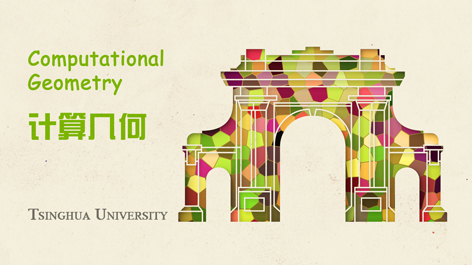
当前课程知识点:计算几何 > 01. Convex Hull > J. Graham Scan: Analysis > 01-J-02. Planarity
有很多种证明的方法
在这里我不妨取出我自己
有心得的两种
第一种我们要证明的
就是从平面性的角度
来看待这个问题
我们可以通过这个
一眼就能看出这个结论
回顾一下这是一张典型的
Graham的计算的过程图
在这个图中蓝色的边
是最终计算出来的凸包
而这些虚线是最开始的那个
我们说的presorting
所得到的那个线
这些线其实是本身是
算帐是算在presorting
那个部分的
不算时间
我们狭义Graham Scan的那个时间
实际上是对这个例子来说
是消耗于这些粗边上的
实边上的
这些实边又进一步
都会分成两类
一类是紫色的,一类是黄色的
黄色的是哪些边呢
黄色的那些是我们欲跨
但是又没有跨过去的
我们在这个地方测试了一下
知道它是一个right turn
所以这地方发生backtrack
而这些紫色的边呢
是更耗费时间的
是我们曾经在那个地方
前进过
比如说从3前进到5
或者从3前进到4
甚至从2前进到3
这都是我们曾经前进过的边
只不过因为后来发现需要回退
捎带着整个这条边也被作废了
无论如何我们花费的时间
无非就消耗在这个
紫色和黄色的边上
而不难验证
每一条边上所花费的时间
一进一出,累积起来也不过
是个常数
那么最重要的一条观察
就是我们整个的这样的
一些黄色和紫色的边合在一起
从图论的角度来看
它是一张平面图
你可以为了说明这件事
可以去证明一下这样
所有被Graham瞄上的
或者曾经走过的那些边
互相之间都不会在内部相交
有了这个就足够了
这就说明它必然是一张平面图
而关于平面图,我们这门课
反复要用到的一个性质就是
欧拉所给出的一个公式
这个公式我们在后面
还会反复地用到
那么在这里我们只简单地
来做一个它的结论的介绍
也就是说根据欧拉公式
平面图中所有的边的数目
包括他们的面的数目加在一起
从渐进的意义上讲
依然是和其中的顶点数目
保持同阶的
不会像你想象的那样
像非平面图那样
可能会多的非常多
超过那个阶次
比如具体来讲
如果一幅平面图
有n个点的话
那么其中所包含的边数
渐进的来说
是不会超过顶点数的三倍的
好了 既然所有的边也不过三倍
那么你这个地方Graham Scan
所能够走过的边也无非如此
顶多顶多三倍
这意味着什么呢
意味着Graham Scan在整个
这个狭义的也就是在
presorting之后的那部分
所消耗的时间
其实不仅远远没有达到N平方
而且确定地来讲
从渐进的来说
它是不超过n的
是个线性的过程
这多少会让你大跌眼镜
当然好在我相信你
知道这个消息以后
肯定会非常地高兴
因为Graham Scan这个算法的效率
果真名副其实
-Before we start
--html
-Evaluation
--html
-Online Judge
--html
-Lecture notes
--html
-Discussion
--html
-A. History of This Course
--00-A. History of This Course
-B. What's Computational Geometry
--00-B. What's Computational Geometry
-B. What's Computational Geometry--作业
-C. How to Learn CG Better
--00-C. How to Learn CG Better
-C. How to Learn CG Better--作业
-D. Why English
-A. Convexity
-A. Convexity--作业
-B. Extreme Points
-B. Extreme Points--作业
-C. Extreme Edges
-C. Extreme Edges--作业
-D. Incremental Construction
--01-D-01. Decrease and Conquer
--01-D-02. In-Convex-Polygon Test
--01-D-03. Why Not Binary Search
-D. Incremental Construction--作业
-E. Jarvis March
--01-E-06. Lowest-Then-Leftmost
-E. Jarvis March--作业
-F. Lower Bound
--01-F-02. CAO Chong's Methodology
-F. Lower Bound--作业
-G. Graham Scan: Algorithm
-G. Graham Scan: Algorithm--作业
-H. Graham Scan: Example
-H. Graham Scan: Example--作业
-I. Graham Scan: Correctness
-I. Graham Scan: Correctness--作业
-J. Graham Scan: Analysis
-J. Graham Scan: Analysis--作业
-K. Divide-And-Conquer (1)
-K. Divide-And-Conquer (1)--作业
-L. Divide-And-Conquer (2)
--01-L-03. Topmost + Bottommost ?
--01-L-07. More Considerations
-L. Divide-And-Conquer (2)--作业
-M. Wrap-Up
-0. Introduction
-0. Introduction--作业
-A. Preliminary
-A. Preliminary--作业
-B. Interval Intersection Detection
-B. Interval Intersection Detection--作业
-C. Segment Intersection Reporting
-C. Segment Intersection Reporting--作业
-D. BO Algorithm: Strategy
--02-D-01. Proximity & Separability
--02-D-02. Comparability & Ordering
-D. BO Algorithm: Strategy--作业
-E. BO Algorithm: Implementation
--02-E-03. Events & Operations
-E. BO Algorithm: Implementation--作业
-F. BO Algorithm: Analysis
--02-F-04. Complexity of Event Queue
--02-F-05. Complexity of Status Structure
-F. BO Algorithm: Analysis--作业
-G. Convex Polygon Intersection Detection
--02-G-01. Problem Specification
--02-G-02. Monotone Partitioning
--02-G-04. Decrease-And-Conquer
-G. Convex Polygon Intersection Detection--作业
-H. Edge Chasing
--02-H-01. Eliminating Sickles
-H. Edge Chasing--作业
-I. Plane Sweeping
-I. Plane Sweeping--作业
-J. Halfplane Intersection Construction
-J. Halfplane Intersection Construction--作业
-0. Methodology
-0. Methodology--作业
-A. Art Gallery Problem
--03-A-02. Lower & Upper Bounds
--03-A-04. Approximation & Classification
-A. Art Gallery Problem--作业
-B. Art Gallery Theorem
--03-B-01. Necessity of floor(n/3)
--03-B-02. Sufficiency by Fan Decomposition
-B. Art Gallery Theorem--作业
-C. Fisk's Proof
--03-C-04. Pigeon-Hole Principle
-C. Fisk's Proof--作业
-D. Orthogonal Polygons
--03-D-01. Necessity of floor(n/4)
--03-D-02. Sufficiency by Convex Quadrilateralization
-D. Orthogonal Polygons--作业
-E. Triangulation
-E. Triangulation--作业
-F. Triangulating Monotone Polygons
--03-F-02. Monotonicity Testing
--03-F-04. Stack-Chain Consistency
-F. Triangulating Monotone Polygons--作业
-G. Monotone Decomposition
-G. Monotone Decomposition--作业
-I. Tetrahedralization
--03-I-01. Polyhedron Decomposition
--03-I-02. Schonhardt's Polyhedron
-I. Tetrahedralization--作业
-A. Introduction
--04-A-02. Dining Halls on Campus
--04-A-03. More Analogies & Applications
-A. Introduction--作业
-B. Terminologies
--04-B-02. Intersecting Halfspaces
--04-B-04. Planar Voronoi Diagram
-B. Terminologies--作业
-C. Properties
--04-C-03. Nearest = Concyclic
--04-C-04. Number of Nearest Sites = Degree
-C. Properties--作业
-D. Complexity
-D. Complexity--作业
-E. Representation
-E. Representation--作业
-F. DCEL
-F. DCEL--作业
-G. Hardness
--04-G-03. Voronoi Diagram In General Position
-G. Hardness--作业
-H. Sorted Sets
--04-H-01. Convex Hull Made Easier
--04-H-02. Convex Hull As A Combinatorial Structure
--04-H-03. Voronoi Diagram As A Geometric Structure
-H. Sorted Sets--作业
-I. VD_sorted
--04-I-06. Sorting Not Made Easier
-I. VD_sorted--作业
-J. Naive Construction
-J. Naive Construction--作业
-K. Incremental Construction
-K. Incremental Construction--作业
-L. Divide-And-Conquer
--04-L-09. Intersecting with Cells
-L. Divide-And-Conquer--作业
-M. Plane-Sweep
--04-M-09. Circle Event: What, When & Where
-M. Plane-Sweep--作业
-A. Point Set Triangulation
-A. Point Set Triangulation--作业
-B. Delaunay Triangulation
-B. Delaunay Triangulation--作业
-C. Properties
-C. Properties--作业
-D. Proximity Graph
--05-D-02. Relative Neighborhood Graph
-D. Proximity Graph--作业
-E. Euclidean Minimum Spanning Tree
-E. Euclidean Minimum Spanning Tree--作业
-F. Euclidean Traveling Salesman Problem
-G. Minimum Weighted Triangulation
-G. Minimum Weighted Triangulation--作业
-H. Construction
--05-H-03. Maximizing The Minimum Angle
--05-H-04. Evolution By Edge Flipping
-H. Construction--作业
-I. RIC With Example
-I. RIC With Example--作业
-J. Randomized Incremental Construction
--05-J-01. Recursive Implementation
--05-J-02. Iterative Implementation
-J. Randomized Incremental Construction--作业
-K. RIC Analysis
--05-K-04. Types Of Edge Change
--05-K-05. Number Of Edge Changes
--05-K-07. Number Of Rebucketings
--05-K-08. Probability For Rebucketing
--05-K-10. Further Consideration
-0. Online/Offline Algorithms
--06-0. Online/Offline Algorithms
-0. Online/Offline Algorithms--作业
-A. Introduction
--06-A-03. Assumptions For Clarity
--06-A-05. Performance Measurements
-A. Introduction--作业
-B. Slab Method
--06-B-02. Ordering Trapezoids
-B. Slab Method--作业
-C. Persistence
--06-C-01. Ephemeral Structure
--06-C-02. Persistent Structure
-C. Persistence--作业
-D. Path Copying
--06-D-03. Storage Optimization
-D. Path Copying--作业
-E. Node Copying
-E. Node Copying--作业
-F. Limited Node Copying
-G. Kirkpatrick Structure
--06-G-01. Optimal And Simpler
--06-G-06. The More The Better
--06-G-07. The Fewer The Better
--06-G-09. Existence Of Independent Subset
--06-G-10. Construction Of Independent Subset
-G. Kirkpatrick Structure--作业
-H. Trapezoidal Map
--06-H-03. Properties & Complexity
--06-H-04. Search Structure: Example
--06-H-05. Search Structure: Nodes
--06-H-06. Search Structure: Performance
-H. Trapezoidal Map--作业
-I. Constructing Trapezoidal Map
--06-I-04. Case 1: Two Endpoints
--06-I-05. Case 2: One Endpoint
--06-I-06. Case 3: No Endpoints
-J. Performance Of Trapezoidal Map
--06-J-03. Number Of Ray Trimmed
--06-J-04. Number Of Trapezoidals Created (1)
--06-J-05. Number Of Trapezoidals Created (2)
--06-J-06. Time For Point Location
--06-J-07. Size Of Search Structure
--06-J-08. Fixed Query Point + Randomly Created Maps
--06-J-10. Probability Of Enclosing Trapezoid Changed
-A. Range Query
--07-A-01. 1-Dimensional Range Query
-A. Range Query--作业
-B. BBST
--07-B-02. Lowest Common Ancestor
-B. BBST--作业
-C. kd-Tree: Structure
-C. kd-Tree: Structure--作业
-D. kd-Tree: Algorithm
-D. kd-Tree: Algorithm--作业
-E. kd-Tree: Performance
--07-E-01. Preprocessing Time + Storage
-E. kd-Tree: Performance--作业
-F. Range Tree: Structure
--07-F-03. x-Query * y-Queries
-F. Range Tree: Structure--作业
-G. Range Tree: Query
-G. Range Tree: Query--作业
-H. Range Tree: Performance
-H. Range Tree: Performance--作业
-I. Range Tree: Optimization
--07-I-04. Fractional Cascading
-A. Orthogonal Windowing Query
-A. Orthogonal Windowing Query--作业
-B. Stabbing Query
-C. Interval Tree: Construction
-C. Interval Tree: Construction--作业
-D. Interval Tree: Query
-D. Interval Tree: Query--作业
-E. Stabbing With A Segment
--08-E-03. Query Algorithm (1)
--08-E-04. Query Algorithm (2)
-F. Grounded Range Query
--08-F-03. 1D-GRQ Using Range Tree
--08-F-04. 1D-GRQ By Linear Scan
-G. 1D-GRQ Using Heap
-G. 1D-GRQ Using Heap--作业
-H. Priority Search Tree
--08-H-03. Sibling Partitioning
-H. Priority Search Tree--作业
-I. 2D-GRQ Using PST
-I. 2D-GRQ Using PST--作业
-J. Segment Tree
--08-J-01. General Windowing Query
--08-J-02. Elementary Interval
--08-J-06. Solving Stabbing Query
--08-J-11. Constructing A Segment Tree
--08-J-12. Inserting A Segment (1)
--08-J-13. Inserting A Segment (2)
--08-J-14. Inserting A Segment (3)
-K. Vertical Segment Stabbing Query








